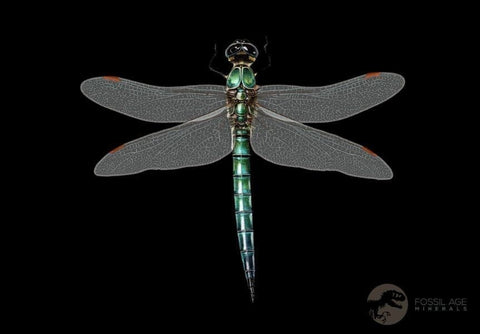0.6" Dragonfly Larvae Fossil Libellula Doris Plate Upper Miocene Piemont Italy Display
Location: Piemonte Area, Santa Vittoria d’Alba. Italy
Weight: 2 Ounces With Display.
Dimensions: 3.3 Inches Long, 2.5 Inches Wide, 1 Inch Thick (Display)
Dimensions: 2.8 Inches Long, 1.2 Inches Wide, 0.2 Inches Thick (Plate)
Insect Dimensions: 0.6 Inches Long, 0.5 Inches Wide
Comes with a Free White Display Box.
Comes with a Certificate of Authenticity.
The item pictured is the one you will receive.
Upper Miocene, 16 Million-Year-old
Fossil Dragonfly Larvae, Libellula Doris
This exceptional fossil plate showcases three complete dragonfly larvae specimens from the Upper Miocene epoch, sourced from a renowned Alpine shale quarry in Piedmont, Italy. Each specimen displays remarkable preservation with intricate anatomical detail, capturing the distinctive morphology of Libellula—a genus of skimmers recognized for their characteristic broad hindwings and elongated bodies. The thin matrix presents the fossils in an aesthetically compelling arrangement, offering a window into ancient aquatic ecosystems. Dragonflies, belonging to the order Odonata, were formidable aerial predators even in prehistoric times, their multifaceted eyes and powerful wing structures perfectly adapted for hunting. This museum-quality specimen represents millions of years of geological history, ideal for serious collectors and natural history enthusiasts seeking authentic paleontological artifacts with scholarly significance.
Female dragonflies lay eggs in or near water, often on floating or emergent plants. When laying eggs, some species will submerge themselves completely to lay their eggs on a suitable surface. The eggs then hatch into naiads. Most of a dragonfly's life is spent in the naiad form, beneath the water's surface, using extendable jaws to catch other invertebrates (often mosquito larvae) or even vertebrates such as tadpoles and fish. They breathe through gills in their rectum, and can rapidly propel themselves by suddenly expelling water through the anus. Some naiads even hunt on land, an aptitude that could have been more common in ancient times, when terrestrial predators were less agile.
Witness the remarkable life cycle preserved in stone—this Upper Miocene fossil plate from Piedmont, Italy, captures dragonfly larvae (naiads) in exquisite detail. These aquatic specimens represent a transformative stage that could span years before metamorphosis, when the naiads would have climbed emergent vegetation to undergo their dramatic emergence into adulthood. The three complete fossils on this thin shale matrix showcase the anatomical features that enabled these ancient predators to thrive in prehistoric wetlands. Once transformed, adult dragonflies possessed unparalleled aerial mastery, capable of moving in six directions with precision and speed. This museum-caliber specimen offers collectors an intimate glimpse into the developmental biology and evolutionary success of Odonata, bridging millions of years between the fossil record and modern dragonfly species.


















